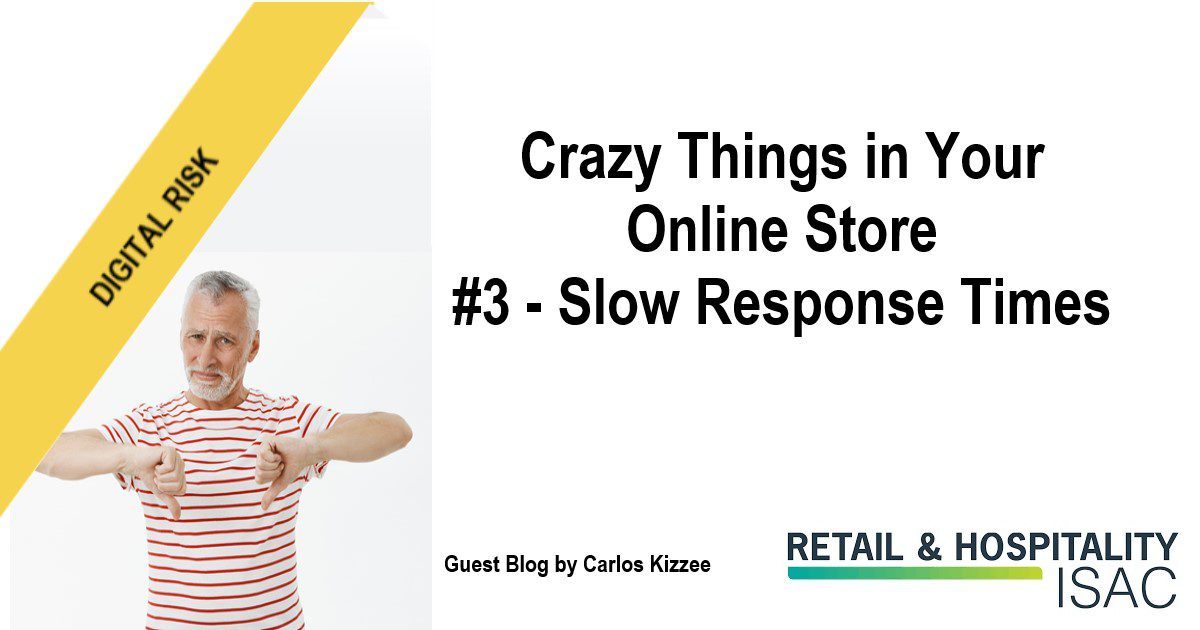
Blog contributed by Carlos Kizzee, Executive Vice President of Intelligence Operations & Legal Affairs, RH-ISAC.
The modern economy revolves around speed. Everything about our lives is moving fast, and we expect our transactions to keep up. When the sites we’re using lag and hang it’s not just annoying—it hurts business.
RH-ISAC and The Media Trust are exploring some of the unexpected aspects of online retail in our series, “Crazy Things that Happen in your Online Store Every Day.” In the third piece in the series, “Crazy Things You Wouldn’t See in a Retail Store,” we looked at the issue of slow response times in online retail eCommerce websites and found it’s a common problem with real repercussions.
We’ve all felt that anxious impatience dealing with a slow website. Maybe our favorite blog takes forever to load new content because of slow-loading ads, or an old internal portal site at work lags because it’s running on a slow server. But when shopping pages lag, our research has shown that it’ll do more than just irritate, it actively drives away customers, and the longer the delay, the higher rate of cart abandonment. While site speed is impacted by a wide variety of factors, two of the biggest culprits for lag are inefficient JavaScript and code requiring a high number of calls to execute.
- JavaScript: Most online stores contain quite a few JavaScript files. JavaScript isn’t bad by itself—it’s a key technology for the modern web. But inefficient, overly-worked, or poorly-coded JavaScript can wreak havoc on speed. It’s not uncommon for simple JS files to take three or more seconds to load: combine a few of those files on one retail website, and that turns into an eternity of delays when we’re expecting instant responses.
- Domains and calls: Website speed is greatly affected by the number of domains operating on a site and the number of calls each of those domains must make. Do you know how many domains are operating on your retail site right now? Many online retail sites have more than a hundred domains executing. If each of those domains has to make a large number of calls, pretty soon the math adds up to customers clicking away from your site in frustration.
Modern retailers can avoid these pitfalls and keep their customers in the fast lane by monitoring their sites closely. Specifically, monitor JavaScript, domains and calls, and any other third-party activity that could cause delays.
- Carefully monitor the number of calls each domain is making, including nested calls, and keep a close watch on the number of additional parties the domains are bringing to your site.
- Monitor JavaScript performance and size. Keep an eye out for JavaScript files over 30KB, as that’s often a sign of bloat and inefficiency.
- Pay close attention to third-party access to your site and restrict it to only trusted sources.
- Monitor the load times of your site frequently, and from a range of different geographic locations and IPs. Discovering (and resolving) spikes in load times will not only reduce the headaches your customers have but may help you detect malicious activity or attacks.
- Slow retail pages are often a symptom of easily-resolved problems—and it’s critical retailers resolve those issues quickly. The faster you make the experience for your customers, the happier they’ll be—and the more likely they are to continue shopping!
Just as with the last “Crazy Things” story: best practices are a retailer’s best friend. The more familiar you are with your website, the better you’ll be, so set up policies to restrict what third party applications can reside on your website, and scan it regularly to verify there aren’t any unexpected visitors.
RH-ISAC and The Media Trust are looking into more surprising, unexpected, and flat-out crazy things that happen in digital stores that wouldn’t happen anywhere else. Check out the other blogs in this series:



